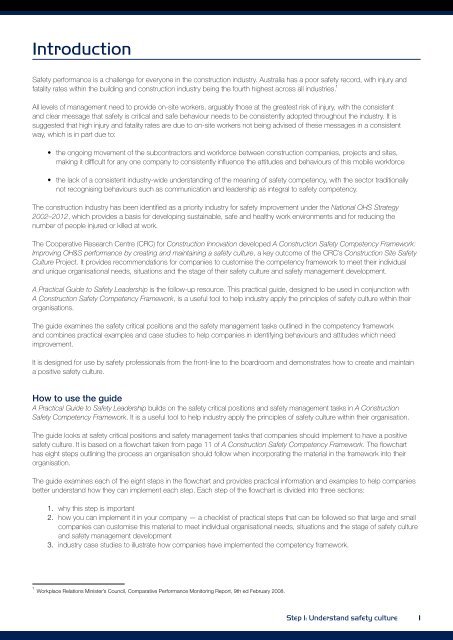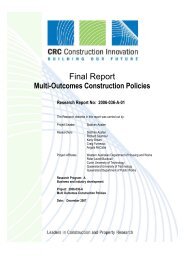A Practical Guide to Safety Leadership Book (PDF 5MB) - QUT ePrints
A Practical Guide to Safety Leadership Book (PDF 5MB) - QUT ePrints
A Practical Guide to Safety Leadership Book (PDF 5MB) - QUT ePrints
You also want an ePaper? Increase the reach of your titles
YUMPU automatically turns print PDFs into web optimized ePapers that Google loves.
Introduction<br />
<strong>Safety</strong> performance is a challenge for everyone in the construction industry. Australia has a poor safety record, with injury and<br />
1<br />
fatality rates within the building and construction industry being the fourth highest across all industries.<br />
All levels of management need <strong>to</strong> provide on-site workers, arguably those at the greatest risk of injury, with the consistent<br />
and clear message that safety is critical and safe behaviour needs <strong>to</strong> be consistently adopted throughout the industry. It is<br />
suggested that high injury and fatality rates are due <strong>to</strong> on-site workers not being advised of these messages in a consistent<br />
way, which is in part due <strong>to</strong>:<br />
• the ongoing movement of the subcontrac<strong>to</strong>rs and workforce between construction companies, projects and sites,<br />
making it difficult for any one company <strong>to</strong> consistently influence the attitudes and behaviours of this mobile workforce<br />
• the lack of a consistent industry-wide understanding of the meaning of safety competency, with the sec<strong>to</strong>r traditionally<br />
not recognising behaviours such as communication and leadership as integral <strong>to</strong> safety competency.<br />
The construction industry has been identified as a priority industry for safety improvement under the National OHS Strategy<br />
2002–2012, which provides a basis for developing sustainable, safe and healthy work environments and for reducing the<br />
number of people injured or killed at work.<br />
The Cooperative Research Centre (CRC) for Construction Innovation developed A Construction <strong>Safety</strong> Competency Framework:<br />
Improving OH&S performance by creating and maintaining a safety culture, a key outcome of the CRC’s Construction Site <strong>Safety</strong><br />
Culture Project. It provides recommendations for companies <strong>to</strong> cus<strong>to</strong>mise the competency framework <strong>to</strong> meet their individual<br />
and unique organisational needs, situations and the stage of their safety culture and safety management development.<br />
A <strong>Practical</strong> <strong>Guide</strong> <strong>to</strong> <strong>Safety</strong> <strong>Leadership</strong> is the follow-up resource. This practical guide, designed <strong>to</strong> be used in conjunction with<br />
A Construction <strong>Safety</strong> Competency Framework, is a useful <strong>to</strong>ol <strong>to</strong> help industry apply the principles of safety culture within their<br />
organisations.<br />
The guide examines the safety critical positions and the safety management tasks outlined in the competency framework<br />
and combines practical examples and case studies <strong>to</strong> help companies in identifying behaviours and attitudes which need<br />
improvement.<br />
It is designed for use by safety professionals from the front-line <strong>to</strong> the boardroom and demonstrates how <strong>to</strong> create and maintain<br />
a positive safety culture.<br />
How <strong>to</strong> use the guide<br />
A <strong>Practical</strong> <strong>Guide</strong> <strong>to</strong> <strong>Safety</strong> <strong>Leadership</strong> builds on the safety critical positions and safety management tasks in A Construction<br />
<strong>Safety</strong> Competency Framework. It is a useful <strong>to</strong>ol <strong>to</strong> help industry apply the principles of safety culture within their organisation.<br />
The guide looks at safety critical positions and safety management tasks that companies should implement <strong>to</strong> have a positive<br />
safety culture. It is based on a flowchart taken from page 11 of A Construction <strong>Safety</strong> Competency Framework. The flowchart<br />
has eight steps outlining the process an organisation should follow when incorporating the material in the framework in<strong>to</strong> their<br />
organisation.<br />
The guide examines each of the eight steps in the flowchart and provides practical information and examples <strong>to</strong> help companies<br />
better understand how they can implement each step. Each step of the flowchart is divided in<strong>to</strong> three sections:<br />
1. why this step is important<br />
2. how you can implement it in your company — a checklist of practical steps that can be followed so that large and small<br />
companies can cus<strong>to</strong>mise this material <strong>to</strong> meet individual organisational needs, situations and the stage of safety culture<br />
and safety management development<br />
3. industry case studies <strong>to</strong> illustrate how companies have implemented the competency framework.<br />
1<br />
Workplace Relations Minister’s Council, Comparative Performance Moni<strong>to</strong>ring Report, 9th ed February 2008.<br />
Step 1: Understand safety culture 1

















